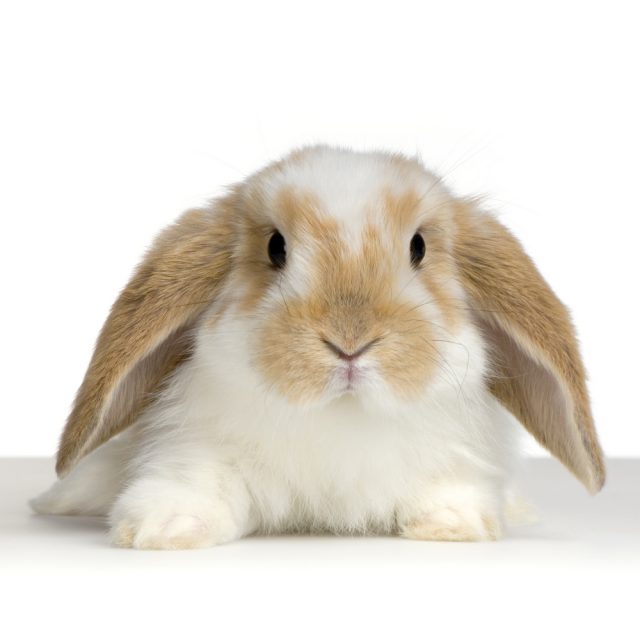Type the name of the breed you're looking for below
[wpdreams_ajaxsearchlite] Don't see the breed your're looking for? Click here and let us know!
Breed Characteristics
1 paw - breed exhibits the least amount of this characteristic
5 paws - breed exhibits most amount of this characteristic
Holland Lop (Miniature Lop)
| Origin | The Holland Lop is a breed of rabbit originating in the Netherlands. The breed was recognized by the Netherlands' Governing Rabbit Council in 1964 and the American Rabbit Breeders' Association in 1979. They are popular house pets, and are very popular and competitive for show. They are also known for their sweet temperament and nonaggressive behavior, though they retain a certain doglike tenacity. Aleck Brook's importation of stock from Holland and the ensuing acceptance of the Holland Lop by the American Rabbit Breeders Association is popular knowledge. But perhaps less known is the breed's history in Europe. A Dutch breed, and one developed by Adriann de Cock of Tilburg, Netherlands, the Holland Lop, or Dwarf Lop as it is known throughout Europe, was recognized by the Netherlands' Governing Rabbit Council in January 1964 whereupon a full standard of perfection was adopted. A long time breeder of the Tan, De Cock was an admirer of both the Netherland Dwarf and French Lop, although of the opinion that the French Lop was handicapped by its large dimensions. During the winter of 1949-50 he obtained a French Lop buck bred to a white Netherland Dwarf doe, he being of the opinion that the resulting litter would be smaller than if the doe were a Lop. The venture failed and, in 1951, a French Lop doe was bred with a Dwarf buck (no easy achievement) and, resulting from the third mating a litter of six was born. All six possessed erect or normal ear carriage, the small closed ears of the Dwarf proving a dominant feature. In 1952 a doe from this litter was bred to a Sooty Fawn colored English Lop buck, producing five young. Of these one doe had lopped ear carriage, two had normal carriage, and the other was half-lopped. Of aggressive nature, the fully lopped doe was never successfully bred. Instead, De Cock bred a doe with one lopped ear from the second litter to a buck from the first litter. The does from the first litter were likewise bred to bucks from the second. These breeding resulted in a percentage of lop-ears which were later interbred with an emphasis on the French Lop type, these traits having been momentarily lost with the infusion of English Lop blood. By 1955 De Cock had a Holland Lop of sorts weighing 2.5 to 3 kg. and in January 1964, he presented four specimens for acceptance each weighing less than 2 kg. Demand in Holland immediately exceeded supply and soon "fast buck merchants" were requesting an increase in weight allowances to 2.5 kg. In 1970, De Cock and twelve supporters founded a Holland Lop Specialty Club with plans to breed the upper weight down to 1.5 kg. as it is now. Dutch stock has since been distributed throughout Europe, especially Belgium, although in Germany and Denmark the Medium-sized "Mini Lop" is more popular. Japanese stock came, I believe via Denmark, Italian via Switzerland and France. The Holland Lop was first brought to England in 1969/70 by George Scott of Yorkshire county via a Dutch contact. Scott had raised a 1.36 kg. buck from this line, although the animal did not breed. Information on further early imports is not readily available, although this author can intimate that Belgian bloodlines and, to his personal knowledge, Netherland Dwarf and French Lop bloodlines had been infused into now British lines. During the winter of 1978/79, a number of Holland Lops, of superior size and type, if slightly inferior ear carriage was imported direct from Holland, and following their six months Government quarantine their effect on the existing bloodlines in Great Britain, particularly England, has been desirable. |
Physical Attributes
| Weight | Less than 4 lbs. (1.8 kg) |
| Ear Type | Lop |
| Fur Type | Rollback |
| Colours | These popular rabbits come in many colours. |
| Appearance | Head is slightly flattened, body is short and looks massive. They have lopped ears and a prominent "crowns" (the ridge of cartilage between the ears) and have soft, fine fur. |
| Other Considerations | Life Expectancy: 5 - 8 years Temperament: People-oriented, affectionate and sensitive to owner, excitable. |
| Best Kept In | Pen. Shed, House or Yard. |



